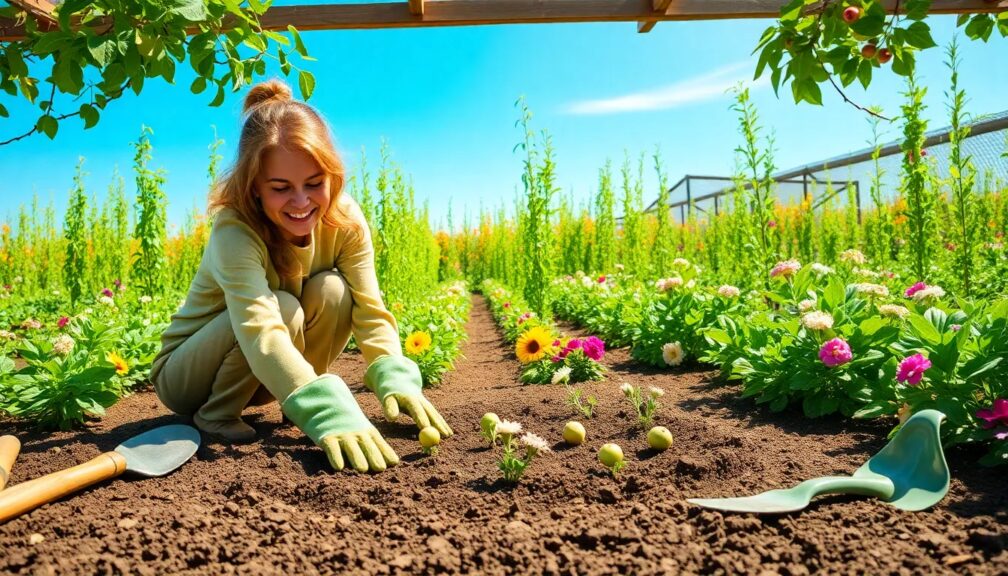How do you start a garden for dummies

Welcome to this article on How to Start a Garden for Dummies
Embarking on the journey of creating your own garden can be both exciting and intimidating, especially if you're a novice with a green thumb in the making. Whether you're looking to cultivate a vibrant flower bed, grow your own vegetables, or simply bring more greenery into your life, starting a garden is a rewarding endeavor that can enhance your environment and well-being. In this guide, we'll walk you through the essential steps to get your garden off the ground, covering everything from selecting the right spot to choosing plants that will thrive in your space. Let's dig into the basics of gardening and transform that patch of earth into a flourishing oasis.
How do I start a garden for beginners?
Imagine stepping into your own slice of paradise, where lush greenery and vibrant blooms await to greet you. The gentle hum of bees, the rich fragrance of soil, and the sheer satisfaction of nurturing life with your own hands. This could be your reality, and starting a garden might just be easier than you think.
First off, let's talk location. You don't need acres of land; a small backyard, balcony, or even a windowsill can become your garden sanctuary. The key is finding a spot with adequate sunlight. Plants love the sun, and most need at least 6 hours of it each day to thrive.
Next is soil. Think of soil as the foundation of your garden. You'll want to get your hands on some high-quality soil that's rich in nutrients. Don't worry; local garden centers usually carry just what you need, with experts on hand to advise you.
Now, let’s talk about what you want to grow. Herbs, vegetables, flowers? The options are endless. Begin with easy-to-grow plants that are known to be forgiving for beginners. Herbs like basil and mint or vegetables like lettuce and radishes can be very rewarding and less daunting for a first-time gardener.
Watering is paramount. Too much or too little can spell disaster for your plants. A general thumb rule is to water deeply but infrequently, encouraging strong root growth. Yet, every plant is unique, so a little research goes a long way.
And you can't forget about tools. A good shovel, gloves, a watering can, and a few other essentials will make gardening not only possible but a pleasure.
The magic of gardening is not just in the blooming flowers or the harvested vegetables; it's in the journey. The process of learning, growing, and connecting with nature is transformative.
But wait, there's more to it. Pest control, fertilizing, and understanding plant cycles all come into play as you delve deeper. The world of gardening is vast and filled with wonder.
So here's the secret—starting a garden might ignite a passion you never knew you had, growing into an endeavor that nourishes both body and soul. The fear of missing out? Absolutely real when it comes to the joys of gardening. Don't let another season pass without digging in. The best part? You're just a few steps away from creating life and beauty right in your own home. Are you ready to embark on this journey? Because your garden paradise awaits.
What is the rule of 3 in gardening?
Imagine uncovering a simple, yet powerful principle that could transform your garden into a vibrant, thriving oasis. The "Rule of 3" in gardening is that coveted secret, a concept that can elevate your outdoor space from mundane to magical. But what exactly is this mysterious guideline, and why are those in the know so reluctant to spill the beans?
At its core, the Rule of 3 taps into the very essence of aesthetic appeal and visual harmony. Picture this: you're strolling through a beautifully manicured landscape, and without realizing it, you're drawn to clusters of plants that somehow seem perfectly balanced. That's the Rule of 3 at work. It's a design strategy that suggests using triplets in your garden arrangements for a reason that has charmed artists and architects for centuries.
The magic number, three, has long been revered in various cultures and disciplines for its perceived perfection and strength. In gardening, applying the Rule of 3 means grouping plants in triads, whether you're dealing with flowers, shrubs, or ornamental grasses. This technique doesn't merely add visual interest; it creates a sense of structure and rhythm that guides the eye and captivates the observer.
But the intrigue doesn't stop at grouping. The Rule of 3 also encompasses the variation in the height, texture, and color of plants. Imagine an ensemble where each member contributes a unique characteristic, yet together, they form a cohesive and enchanting display. The tallest plant might lend a dramatic backdrop, while the medium and shorter companions offer a cascade of colors and textures that tease the senses.
The implications of this rule extend beyond the individual clusters. When applied across your garden, the Rule of 3 contributes to a sense of continuity and flow, leading the viewer on a journey through your living masterpiece. With each step, a new trio of plants catches the light, each arrangement a chapter in an unfolding story.
Yearning to unlock the full potential of your garden? Craving the secret that will set your green haven apart? The Rule of 3 isn't just another gardening tip; it's a philosophy that can revolutionize the way you view and interact with your outdoor sanctuary. And yet, this is just the tip of the iceberg. There are more layers, more nuances to this principle that can further refine and define your garden's aesthetic.
Stay tuned as we delve deeper into the Rule of 3, exploring how to select the perfect plants, and combine shapes and textures for maximum impact. Your garden is a canvas, and with the Rule of 3, you're about to become the artist who brings it to life.
How to make a garden step by step for beginners?
Imagine stepping outside into your own slice of paradise, where verdant leaves sway and vibrant flowers bloom. The secret to transforming your outdoor space into this serene sanctuary is simpler than you might think. With a little guidance, creating your own garden is a journey not only of cultivating plants but of personal fulfillment as well.
Starting a garden ignites a connection with nature that can be incredibly rewarding. If you've been dreaming about it but don't know where to begin, fear not! Here lies the treasure map to your verdant kingdom.
Step 1: Choose the Ideal Location
The sun is your garden's best friend. Most vegetables and flowers require at least six hours of sunlight per day. Observe your potential garden area throughout the day to find that sun-kissed spot.
Step 2: Plan Your Garden Beds
Once you've nailed the location, it's time to decide on the layout. Raised beds are a popular choice for beginners due to their ease of maintenance and better soil conditions.
Step 3: Invest in Basic Tools
You don't need an arsenal, just some key tools to get you started. A spade, trowel, gloves, and watering can will be your initial allies in the gardening world.
Step 4: Test and Prepare Your Soil
Your plants' health is directly tied to the quality of your soil. Testing it will reveal what you're working with and whether you need to amend it with compost or fertilizer.
Step 5: Select Your Plants
Choose plants that will thrive in your climate. Beginners might start with easy-to-grow species that promise success and build confidence early on.
Step 6: Plant with Care
Learn about the needs of your chosen plants—how deep to plant them, how far apart, and how much water they require. Planting is an art that sets the stage for growth.
Step 7: Water Wisely
Water is life. Doing it correctly is crucial. Early morning is the best time to water to reduce evaporation and fungal diseases.
Step 8: Mulch Matters
Mulch conserves water, keeps weeds at bay, and improves soil quality. It's an unsung hero in the garden.
Step 9: Keep Up with Maintenance
Regularly check for pests, diseases, and weeds. Prompt action can prevent small issues from becoming big problems.
Step 10: Enjoy and Learn
Experience is the best teacher in gardening. Take pleasure in the process, and don't be afraid to experiment.
The journey to creating your own garden is filled with potential twists and surprises, but the satisfaction of watching your garden grow is unparalleled. Each step brings its own joys and challenges, and as you delve into this guide, your garden will begin to take shape before your eyes. The world of gardening awaits, and it's ripe with possibilities. Don't wait any longer; the time to plant your dreams is now.
What is the most common mistake of first time gardeners?
The journey into gardening can be as thrilling as it is daunting; the promise of nurturing life from the soil often comes with a side of rookie errors. The most prevalent misstep, lurking in the shadows of enthusiasm, might surprise you. It's not about exotic pests or complex fertilization formulas—it's something far more fundamental.
Imagine this: you've gathered your tools, chosen your seeds, and you're ready to transform a patch of earth into a verdant oasis. However, in the eagerness to see those first sprouts push through the dirt, many novices fall prey to the same simple yet critical error.
Picture the sun, a life-giving force that dances across your garden; its rays are vital, yet too much can be as detrimental as too little. The mistake? Misjudging the sunlight. Your fledgling plants crave it, but without the proper balance, they may either languish in the shade or wither under a harsh glare.
But that’s just the beginning. Avoiding this initial pitfall opens the door to a world where soil composition, watering practices, and plant spacing become characters in an unfolding drama of growth and bloom. If you've ever wondered why your tomatoes never turned that juicy red or why your basil wasn't as fragrant as you hoped, the answer often lies in these early decisions.
You might be thinking, "Surely, it can't be that simple?" Oh, but it is, and the implications are vast. The interplay of light with other elements such as moisture and nutrients can lead to a cascade of gardening triumphs or tribulations.
Ready to unlock the secrets of a thriving garden and avoid the common pitfalls that keep first-time gardeners from reaching their lush, bountiful potential? Stay tuned as we delve deeper into the art and science of cultivating a vibrant garden, one that beckons you and others to witness its splendor.
How to start a vegetable garden in your backyard
Imagine stepping outside your back door to a thriving patch of fresh greens, juicy tomatoes, and crisp cucumbers waiting to be picked. The aroma of fresh herbs and the buzz of pollinators create a symphony of nature's bounty right at your fingertips. Starting your own vegetable garden can transform your outdoor space into a sanctuary of sustenance, but many hesitate, fearing they lack the green thumb or time to cultivate a flourishing harvest. Fear not! The secrets to unlocking the earth's potential are within reach, and the journey is packed with rewards that go beyond the plate.
Unlock the mystery of soil composition and discover how its delicate balance can make or break your garden dreams. Learn selecting the right location is not just about convenience; it's about giving your plants the sunlight they crave and the protection they need to thrive. Delve into the wonders of companion planting, where certain plant pairings not only coexist but help each other grow, deterring pests and boosting yields.
But where to start? Begin by mapping out your space, considering factors like exposure to the elements and accessibility. Don't let limited space dampen your spirits; container gardening can yield a surprising abundance of produce from the smallest of balconies or patios.
Next, let's talk about seeds versus seedlings. The options are plentiful, and each has its advantages. Will you experience the magic of nurturing a plant from its embryonic state, or would you prefer the head start that seedlings offer?
As you embark on this journey, remember that patience and persistence are your allies. Sometimes the most challenging gardens yield the richest lesson—and the sweetest carrots. With each day, as your hands work the earth and your garden takes shape, you'll find that what you grow is more than food; it's a living, breathing extension of your home.
Curious about organic practices? Craving the secrets to pest control without chemicals? Eager to know the top five beginner-friendly vegetables that promise a generous harvest? The adventure has just begun, and the promise of fresh, homegrown produce is within your grasp. Don't let another season pass by; start your gardening journey today and taste the difference tomorrow. Your backyard oasis awaits.
Consejo final: Remember to enjoy the process of creating your garden. Gardening is as much about the journey as it is about the end result. Embrace the learning experiences and allow yourself to grow along with your garden. Wishing you a bountiful and rewarding adventure with your new green space. Take care and happy gardening!
 What is the easiest garden to start
What is the easiest garden to start Is it OK to mix compost with potting soil
Is it OK to mix compost with potting soil Should I mix the compost with soil or leave on top
Should I mix the compost with soil or leave on top Do I need to mix compost with topsoil
Do I need to mix compost with topsoil When not to use a tiller
When not to use a tillerIf you want to know more about similar articles like How do you start a garden for dummies you can visit category Gardening Tools.